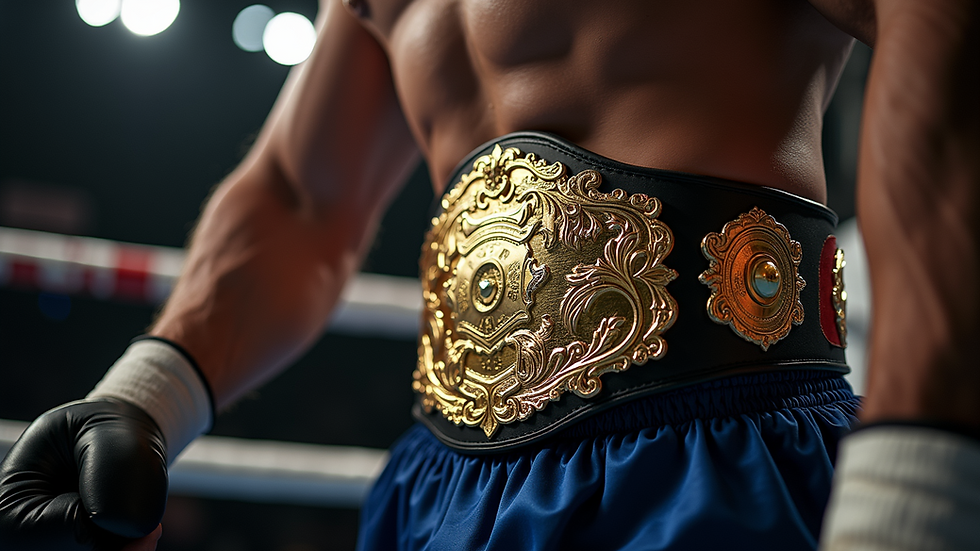The Evolution of Compensation in Professional Fighting: A Journey Through the Years
- kennyherrholz

- Jun 19, 2025
- 4 min read
The world of professional fighting has transformed dramatically over the years. It's not just about techniques, training, and fan engagement; the financial rewards for fighters have undergone significant changes too. The story of fighter compensation reflects the sport's growth, cultural impact, and the evolving landscape of athlete pay. In this discussion, we explore the evolution of compensation in professional fighting, highlighting key milestones and factors influencing these changes.
Historical Context of Fighter Pay
Professional fighting spans various disciplines such as boxing, mixed martial arts (MMA), and wrestling, with a history that dates back centuries. Early fighters competed mainly for honor and local fame, earning little in return. However, as combat sports became more organized with the formation of professional leagues, the potential for substantial earnings began to take shape.
In the early 20th century, boxing rose to prominence, allowing fighters to earn modest paychecks for their efforts. Iconic figures like Jack Johnson, who became the first African American heavyweight champion in 1908, pushed the boundaries of what fighters could earn. Yet, it was during the mid-20th century that significant payouts began to materialize, fueled by television broadcasts and an expanding fan base.
As boxing's popularity surged during the 1960s and 1970s, fighters like Muhammad Ali and George Foreman earned millions per fight. Ali’s iconic bouts against Sonny Liston and Joe Frazier brought in large audiences, demonstrating that top-level fighting could be lucrative.
The Transformation in Mixed Martial Arts
The emergence of MMA in the 1990s marked a turning point for fighter compensation. Early on, the sport was primarily associated with the Ultimate Fighting Championship (UFC) and was initially seen as a brutal show. Over time, with stricter regulations and increased audience acceptance, MMA gained respect and traction.
In the sport's early days, many fighters made less than $10,000 per fight. Fast forward to the late 2000s and early 2010s; as MMA became more popular, earnings changed dramatically. Major pay-per-view events like UFC 100 generated over $100 million in revenue, with fighters starting to see a portion of this income.
The UFC has been pivotal in reshaping fighter earnings by introducing a structured pay scale. This includes base salaries, performance bonuses, and shares of pay-per-view revenue—a model that incentivizes fighters while attracting top-tier talent.
Key Milestones in Fighter Compensation
The Rise of Pay-Per-View Revenue
Pay-per-view events revolutionized fighter pay. They allowed promotions to earn huge profits, which directly impacted how much fighters received. For example, UFC 68 in 2007 generated $3.3 million in gate revenue and over 1 million pay-per-view buys. Fighters like Randy Couture benefited significantly, with his earnings reflecting the event’s success.
By the end of the 2010s, stars such as Conor McGregor were reportedly earning upwards of $3 million per fight, depending on pay-per-view sales, with some bouts generating tens of millions in total revenue.
The Advent of Sponsorships and Endorsements
As professional fighting gained popularity, so did sponsorship and endorsement opportunities. Fighters increasingly attracted major brands looking to partner with them. For instance, the UFC's deal with Reebok in 2015 allowed fighters to earn a set fee for wearing Reebok gear, although this approach did raise concern among some fighters regarding individual sponsorship rights.
Today, endorsements significantly boost fighter income. High-profile fighters like McGregor often earn more through their endorsements than their actual fight purses. This trend shows the effectiveness of building personal brands within the sport.
Minimum Fighter Compensation
Organizations such as the UFC have faced scrutiny for their fighter compensation, especially regarding minimum payouts. For debut fighters, base salaries can start around $10,000, which, while better than in the past, still lags compared to other sports. In basketball and football, for example, rookie salaries start at six figures.
The push for higher minimum payouts is growing, with many fighters advocating for fair compensation that aligns with the rising revenues of promotions. As the UFC generates more income, the demand for fairer earnings is likely to intensify.

The Impact of Social Media and Online Platforms
Social media has greatly changed how fighters promote themselves and negotiate their worth. Fighters can now engage with fans directly, allowing them to build their brands and increase their income potential.
Platforms like Instagram, Twitter, and TikTok provide direct access to audiences and create lucrative opportunities. For example, McGregor has effectively utilized his social platforms to secure endorsement deals, significantly amplifying his financial success.
Fighters are now more financially savvy, using their online presence to control their narratives and build their brand identity.
The Current State of Fighter Compensation
The fighter compensation landscape today is multifaceted. Financial dynamics hinge on individual skill, marketability, and the promotion involved. Top-level fighters can earn millions; for instance, UFC Main Events promise paychecks starting at $500,000, with extra income from performance bonuses and pay-per-view shares.
Conversely, fighters in less prominent promotions still face financial struggles. There are ongoing concerns about pay equity across the sport, particularly as female fighters often earn less than their male counterparts, despite increasing fan interest in women’s fights.
Future Prospects for Fighter Pay
As professional fighting evolves, so will fighter compensation. Several trends may shape the future of pay:
Growing Viewership and Revenue: The international expansion of combat sports and the rise of streaming platforms may open doors for increased revenue, which should positively impact fighter pay.
Health and Safety Regulations: Increased focus on fighter health and safety might lead to better insurance and support practices, reshaping how financial resources are allocated among fighters.
Enhanced Negotiation Power: As fighters gain more opportunities for sponsorships and media deals, they could leverage this for better pay and contract terms.
Advocacy for Fair Pay: As fighters unite and engage in advocacy efforts, there may be stronger pressure on promotions to address pay disparities and foster equitable compensation practices.

Reflecting on Fighter Compensation
The evolution of fighter pay is intertwined with the growth of combat sports and reflects larger trends in athlete compensation. From earning modest fees in bygone eras to securing multi-million-dollar contracts today, the changes are striking.
As the industry continues to evolve, it remains crucial for fighters to advocate for fair compensation that truly reflects their contributions. The financial disparities within the sport serve as a reminder that the journey toward equitable earnings is ongoing, ultimately shaping the experiences of future generations in combat sports.



